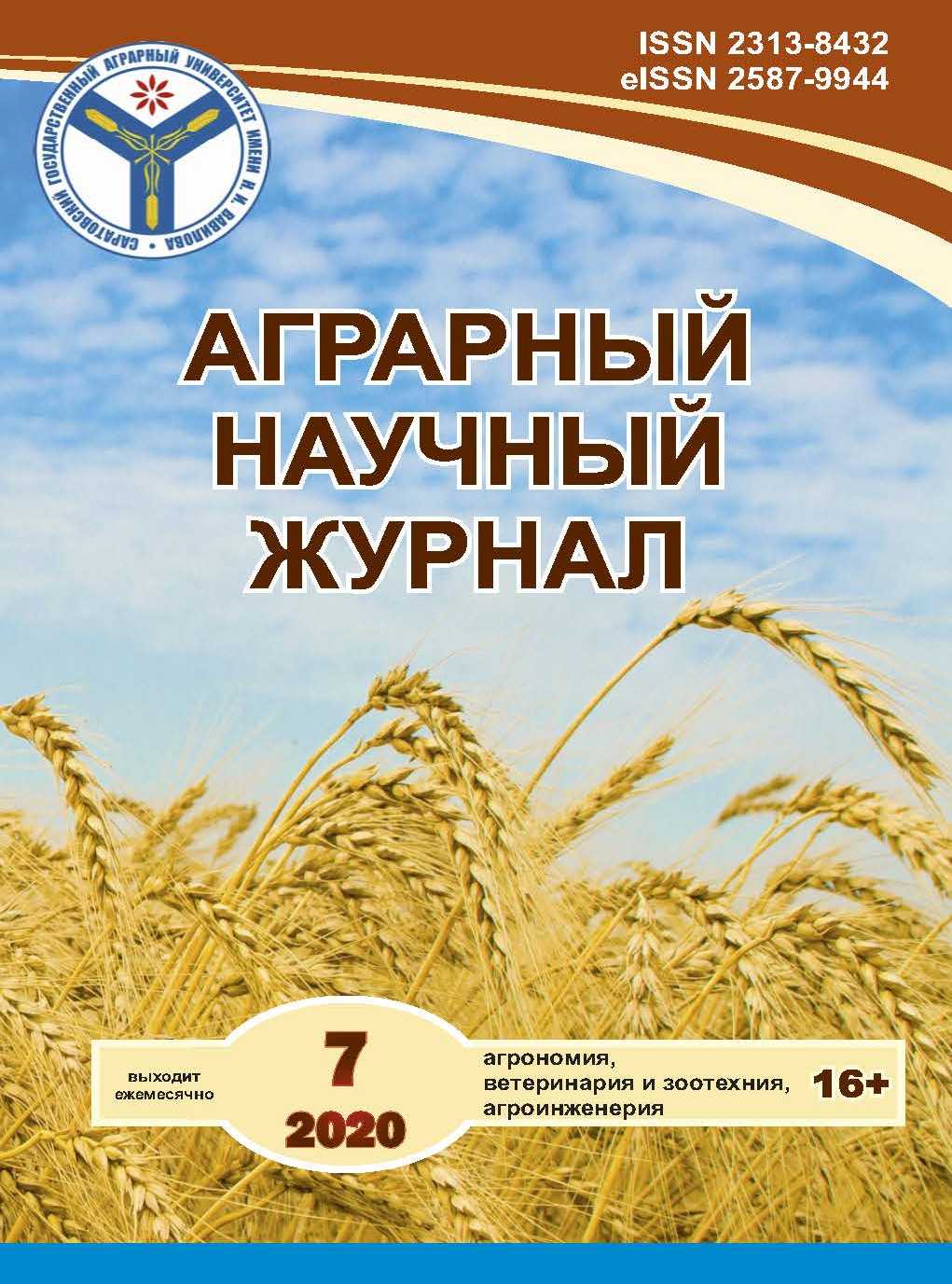Realization of potential productivity of winter crops in the Middle Volga region
DOI:
https://doi.org/10.28983/asj.y2020i7pp15-19Keywords:
rye, triticale, wheat, actual and potential yieldAbstract
The study of 5 varieties of winter rye, 6 varieties of winter triticale and 2 varieties of winter wheat of winter crops was carried out in the breeding fields of the Samara niish, located in the steppe zone of the Middle Volga region, in the nursery of competitive testing in 2002-2019. For scientific justification, we calculated the potential productivity (Ut), the really possible potential yield (Double p), the really possible maximum yield (Double m), the bioclimatic potential (BCP), and correlation analysis. The purpose of the work: to determine the possible yield of winter crops and propose measures to achieve the data obtained in the arid conditions of the Volga region. In the conducted studies, the maximum yield of triticale was obtained in 2017 – 7.48 t / ha, rye-5.88 t / ha, wheat in 2016-4.65 t / ha. The potential yield, taking into account ?T10°C for the growing season of the crop, for triticale was obtained in 2017 -3.02 t / ha, for winter rye in 2005-6.83 t / ha, for winter wheat in 2005-2.79 t / ha. The variation of the indicator (BCP) over the years reached significantly higher values from 0.62 to 1.16 points for winter rye, from 0.30 to 0.60 for winter triticale and wheat. With rational plant protection from weeds, pests and diseases and optimal plant nutrition, the studied varieties are able to grow intensively in the arid conditions of the Volga region, form a good strong root system, a well-developed conducting stem system, a large ear that can intensively use the flow of heat energy, and consistently provide a yield of 3.0-4.0 t / ha.
Downloads
References
2. Вьюшков А.А., Шевченко С.Н. Биоклиматический потенциал культуры яровой пшеницы и его реализация в условиях Среднего Поволжья // Известия Самарского научного центра Российской академии наук. Спец выпуск: «Развитие научного наследия академика Н.М. Тулайкова» (к 105-летию Самарского научно-исследовательского института с.-х. им. Н.М. Тулайкова). – Самара: Самарский научный центр Российской академии наук. Президиум СНЦ РАН, 2008. – С. 63–70.
3. Горянин О.И., Горянина Т.А. Эффективность возделывания сельскохозяйственных культур в степном Заволжье // Аграрный научный журнал журжужурнал. – 2013. – № 11. – С. 19–22.
4. Горянина Т. А. Сравнительная оценка сортов озимой тритикале по адаптивной способности и стабильности // Достижения науки и техники АПК. – 2020. –Т. 34. – № 1. – С. 37–41.
5. Горянина Т.А., Медведев А.М. Влияние климата на урожайность и качество зерна сортов тритикале в Заволжье // Аграрный научный журнал. – 2019. – № 12. – С. 9–14.
6. Грабовец А.И., Фоменко М.А. Изменение климата и методология создания новых сортов пшеницы и тритикале с широкой экологической пластичностью // Достижения науки и техники АПК. – 2015. – Т.29. – № 12. – С. 16–19.
7. Каюмов М.К. Программирование урожаев с.-х. культур. – М.: Агропромиздат, 1989. – 317с.
8. Колосков П.И. О биоклиматическом потенциале и его распределении на территории СССР // Труды НИИАК. – 1963. –Вып.23. – С. 90–111.
9. Методические рекомендации по определению потенциальной и реальной продуктивности пшеницы / Ф.М. КУперман [и др.]. – М., 1980. – 40 с.
10. Туктарова Н.Г. Влияние современных тенденций изменения климата на урожайность озимых зерновых культур // Пермский аграрный вестник. – 2019. – №1 (25). – С.80–86.
11. Федотов А.А., Лиходиевская С.А., Хрипунов А.И. Влияние засух на урожайность озимой пшеницы // Достижения науки и техники АПК. – 2014. –Т. 28. – №11. – С. 19–21.
12. Asseng S., Foster I., Turner N.C. The impact of temperature variability on wheat yields // Global change biology, 2011, Vol. 17, Is. 2, P. 997–1012.
13. Goryanin O.I., Chichkin A.P., Dzhangabaev B.Z., Shcherbinina E.V. Scientific bases of stabilization of humus in ordinary chernozem in Russia // Polish Journal of Soil Science, 2019, Vol. 52, № 1, P. 113–128.
14. Fayaz N., Arzani A. Moisture stress tolerance in reproductive growth stages in triticale (X Triticosecale Wittmack) cultivar sunder field conditions // Crop Breeding Journal, 2011, № 1(1), Р. 1–12.
15. Khalifeie N., Mohammadi Nejad G. Evaluation of salt tolerance of new Tritipurum lines, Triticale and Iranian wheat lines // Advances in Natural and Applied Sciences, 2012, № 6(2), Р. 206–212.
16. Kirchev H., Perchev E., Georgieva R. Yield plasticity and stability of triticale varieties (X Triticosecale wittm.) under increasing nitrogen fertilization norms // Research journal of Agricultural Science, 2016, № 48(2), P. 65–68.
17. Licker R. et al. Mind the gap: how do climate and agricultural management explain the «yield gap» of croplands around the world? // Glob. Ecol. Biogeog, 2010, № 19, P. 769–782.
18. Lonbani M., Arzani A. Morpho-physiological traits associated with terminal drought-stress tolerance in triticale and wheat // Agronomy Research, 2011, № 9 (1–2), Р. 315–329.
19. Ray D., Ramankutty N., Mueller N. et al. Recent patterns of crop yield growth and stagnation // Nat. Commun, 2012, № 3, 1293 p.








